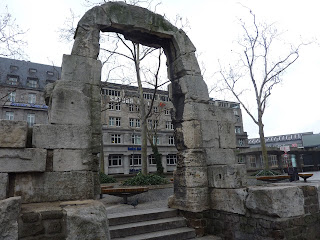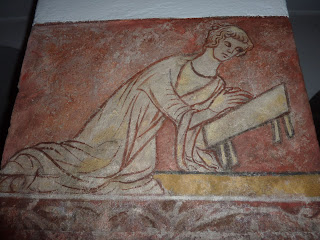24. 01. 2012
If Monday is Men’s Night Out in Cologne, then Tuesday morning is inexplicably when middle-aged women put on Halloween costumes, wander around the city in large groups, and light votives in the Cathedral. Ah, it turns out Cologne has Carnival, and this is the beginning of the celebration, which explains the dissonance of witches lighting votive candles.
Cologne is a very Catholic city. Germany may be the home of the Reformation, but the Counter-Reformation also took hold, and the opposing forces have always held a fragile balance. A few years ago we went to a talk by a historian who had just written a book on how churches maintained a balance within cities and towns when both sides wanted the nice old local church or cathedral in the Post-Reformation era. Church sharing was not uncommon.
Cologne was a very powerful Catholic city during the Middle Ages, and a great place to visit very old churches today. When we were here several years ago I found a book, with English text, that included a walking trail of a dozen Romanesque churches. It was a spectacular way to spend a day. I am not a big fan of gold embellished, over-ornamented Baroque churches, and in Germany, most old churches have been Baroqu-ed to remain fashionable with the Counter-Reformation crowd. Thankfully, Cologne’s oldest churches seem to have resisted that trend.
Last time I was here I spent all day on the Romanesque churches, and had little time left over for Cologne's Cathedral. So this time I began my day with the Cathedral. A tour in English begins at 10:30 every weekday morning, and because this is not a busy season, I was the only punter on hand. The guide said, since we were both there, he may as well give me a private tour. I’m so glad he did because there are so many small treasures in the building, I might not have recognised their significance.
Most cathedrals are built in sections over extended periods of time, but Cologne took 632 years and two months according to the official guidebook. There was a 300 year break between the 16th and the 19th centuries when the north tower, the nave and the transepts were left unfinished. During Napoleon's occupation of the city, grain and forage was stored in the structure. In 1815, Cologne became part of Prussia and repairs and building works began again. The last stone was laid in 1880.
The first important thing about the Dom is how much light filters in because the curtain walls are nearly all glass, and I was lucky to be visiting on a sunny day.
My guide said there is evidence that the master mason of Amiens Cathedral in France is responsible for the design, and his remit was to make the Dom taller and brighter than Amiens.
There is still some medieval glass with the superb colours achieved by glassmakers whose secrets have been lost. This glass was removed and stored before the bombing raid that shattered windows and vaults. There are some brighter than bright 19th century windows donated by King Ludwig I of Bavaria that knock your socks off as the sun streams through reds and yellows, but the most interesting window is as contemporary as you can get, a window designed by Gerhard Richter for the south transept. Small squares of beautiful colours with a pattern designed digitally. In a new technique, the squares were bonded to a sheet of plain glass, so it is high-tech artistic double glazing.
And because it was a sunny day, I could just capture the wonderful colours of light reflected on the stone work from the window.
Reliquaries were the secret to success for medieval foundations. Cologne latched on to one of the most sought after: the Three Kings, yes The Magi themselves. Constantine’s mother was a very busy archaeological detective. I knew that she had found The True Cross, but I didn’t know that she went on to find the Magi. They were first sent to Milan, but when Barbarossa captured Milan, with aid from the bishopric of Cologne, the relics were translated—which is the proper term I learned in the class on reliquaries I joined last autumn—to Cologne. The city became an important stop on the pilgrimage route to Compostela to pick up a blessing from the Three Kings who were housed in a three coffin size reliquary of beaten silver coated with a fine layer of gold in the earlier Romanesque cathedral.
The reliquary is still in place behind the high altar, but surrounded by a strong metal grille screen. On this day there were repairs underway in the choir, so that area was completely closed off. My guide told me that the last time the reliquary was opened, in the late 19th century, the remains of three people were found wrapped in cloth that was determined to be from Palmyra in Syria and dated to the 1st century. The pilgrimage income was the also the pot of gold used to begin construction of the new style Gothic Cathedral to replace the old Cathedral on the site.
In this 19th century mosaic floor by the pottery firm Villeroy & Boch, Hildebold, who was Archbishop from 787 to 818 is holding a model of the old cathedral.
Other important treasures include the 14th century altarpiece of St.Clare.
The Adoration of the Christ Child by the Three Kings painted in the 1440s by Stephan Lochner for the city's Rathaus Chapel. The attribution is known because Albrecht Dürer made a note in his diary when he visited Cologne and saw the altarpiece. Cologne's oldest patron saints are depicted on the wings, Ursula on the left and Gereon to the right.
And the remarkable Gero Crucifix, named for the bishop who held office from 969 to 976, and commissioned this sculpture for the earlier church. The Christ figure is six and a half feet tall, and probably was displayed in the centre of the chancel arch of the nave. The marble base and gilded sun are Baroque embellishments. A singular crucifix, and one with a dead Christ, were the equivalent of contemporary "shock art" in the 10th century, and had a profound influence on subsequent religious sculpture. It is a very compelling work with it's stretched and strained muscles and slumping belly of a man suffering a tortuous death.
Cologne's Krippen is also still in place in the entrance hall, and I read local custom is to leave them on display until Candlemas, February 2, the celebration of Jesus being presented to the Temple elders. So now I know the deadline for putting away my last Christmas decorations next week.
Cologne's Krippen is large and local and funny.
Cologne's Krippen is large and local and funny.
 |
| A Cologne setting |
 |
| With a lazy farmer waiting to rent out his empty stable |
 |
| In a Roman city |
 |
| Where an elephant takes the Magi |
 |
| To Cologne Cathedral |
 |
| To be met by public servants in reflective gear |
Cologne was settled by the Romans in the 1st century and became an important capital city of the Empire with its vital bridge across the Rhine. There are Roman remains everywhere dotting the city.
Since I still had a few hours left in Cologne, I decided to pay homage to the traditional patron saints of the city by dropping in at their churches.
My favourite is Ursula, a 4th century Romano-British princess who set off across the English Channel with 11,000 Virgin handmaidens for her arranged marriage to a pagan prince of Brittany. A storm at sea made her decide to undertake a pilgrimage to Rome to see the Pope, who then joined her, and they all set off for Cologne which was under attack by the Huns. Ursula was martyred and her 11,000 Virgins were beheaded according to a 5th century inscription. I stopped off at St. Ursula’s church, the site of the massacre according to the inscription, but it was the early afternoon closure time, so I could just peek into the sanctuary. The last time I was in Cologne I saw the church’s special treasure room with the relics of the 11,000 housed in golden Baroque splendour. It is overwhelming, but not in a good way. My favourite depiction of the Ursula legend is Hans Memling's painted shrine in Bruges.
 |
| Random stones outside the Roman Museum |
 |
| The North Portal to the Roman City |
Since I still had a few hours left in Cologne, I decided to pay homage to the traditional patron saints of the city by dropping in at their churches.
 |
| A lovely modern window in the porch at St. Ursula's |
 |
| This is the Gothic apse end of St. Gereon's, not the Roman Dome. |
On the way between the two churches, in the heart of Cologne's financial district, I passed a small Holocaust monument by the side of the pavement. I haven't been able to find any information about the piece.
 |
| My personal interpretation runs along the lines of a religious figure, a nun, turning her back on the evidence of anti-semitic genocide |
 |
| And turning her Christian principles into a piece of old leather |
 |
| to be tossed on a pile of shoes, which have become an evocative symbol used in so many memorials to the Holocaust. |
 |
| Scientist, Philosopher, Theologian |
 |
| Watched over by a medieval scribe |
with superb stiff-leafed Romanesque carving around the capitals and cornice
and wall paintings in the nave chapels.
Finally, there is the golden Shrine of the Holy Maccabees, from the early 16th century, that commemorates the remains of the Jewish mother who watched her seven sons martyred for refusing to eat pork, a tale told with variations in detail, in the Talmud and in the Christian Apocrypha's 2nd and 4th Books of the Maccabees.



















No comments:
Post a Comment